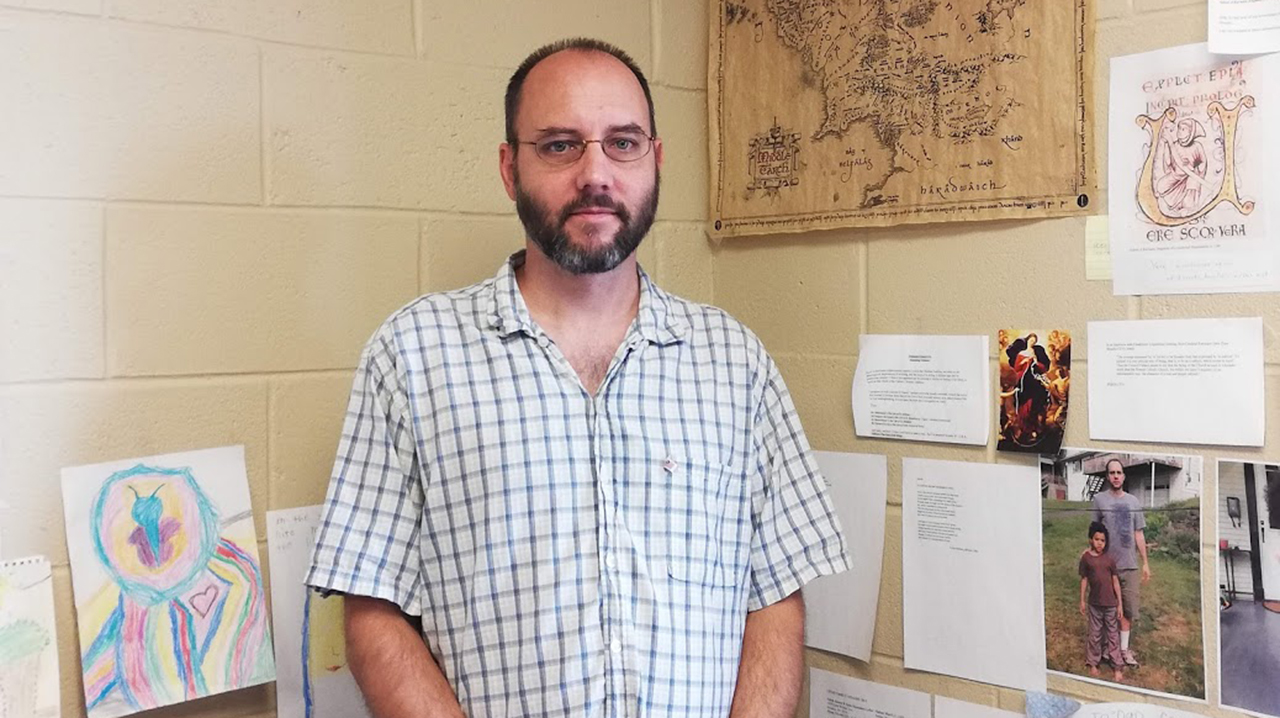Professor is Teaching Something 'True and Real'

Nathan Lefler, Ph.D., associate professor of Theology/Religious Studies, spoke with us recently about studying Flannery O'Connor's “The Displaced Person" during intersession.
What do you enjoy about teaching theology/religious studies at Scranton?
I am grateful to be asked this question. I think what I enjoy most is the opportunity to try to convey effectively -- to teach -- something true to my students each year -- something true and real. Thomas Aquinas says you can only teach what you know perfectly, which sounds very daunting, probably because one hears it and thinks, "So, I have to know everything to be able to teach anything!" But that's not what he says: only that what you teach, you have to know. So, I can teach my 10- and 12-year-olds the rudiments of arithmetic and algebra without really understanding much at all about higher math.
And so, I try each semester to teach the college theological equivalent of the basic arithmetic operations: First, that God really is Love - not just that he loves us, but that he is Love, in his nature, which means love through and through and nothing else but love. Second, that we human beings are made, by Him, in His image, which means that we are like Him in our created nature -- which means that we are made not merely with the ability to love when we feel like it, but that we are made lovers by nature -- lovers of everything and especially of everyone. Love is relationship. So the real foundation of our being lovers by nature is that the God who made us like Himself is a personal relationship, between three perfect lovers, and so we, by our deepest nature, are made for, and yearn for, and are capable of, loving others and being loved by them. I also get to talk a lot about Jesus in my theology classes, whose story fills out - literally embodies (or incarnates) the two points above. So "that's it," in a nutshell.
What are your goals for the use of your intersession grant?
To write and publish a paper on the connections between the thought of the great late-20th century literary theorist and anthropologist, Rene Girard, and the work of Flannery O'Connor, focusing on one of her longer short stories, "The Displaced Person."
What drew you to study Flannery O'Connor's “The Displaced Person"?
This is one of O'Connor's great masterpieces. On the surface, it's about a Polish refugee brought with his family to the American South shortly after the end of the Second World War. Mr. Guizac, the so-called "Displaced Person" (an official designation by the U.S. government. Truman signed the first Displaced Persons Act on June 25, 1948.), arrives for work on Mrs. McIntyre's small struggling dairy farm and proves immediately to be a highly skilled worker, which generates tensions with longstanding employees. Soon, and somewhat mysteriously, he falls out of favor with Mrs. McIntyre as well, who begins to speak of him as "extra." Mrs. McIntyre cannot afford what is extra, and so, the story comes to a tragic end, on a certain level, with the not quite accidental death of Mr. Guizac. But the story has many levels. In the penultimate scene, Mrs. McIntyre almost simultaneously recognizes her collusion in Mr. Guizac's death, and that she herself is somehow a profoundly displaced person. Jesus, too, was a displaced person, and so, Flannery O'Connor insists, are all of us, and if only we can see that in time, we may discover the possibility of stepping out of the endless cycles of mimetic rivalry and violence that constantly threaten to consume and even annihilate us. Girard's elaborately articulated mimetic theory serves to elucidate O'Connor's spiritual and theological insights in several ways, and the story, in turn, helps to verify aspects of Girard's theoretical edifice. There are ways, too, that Aquinas's theology of nature and grace, skillfully deployed by O'Connor, cries out for a more deliberate engagement by mimetic theory than has been mounted heretofore by more than a very few theologians.
What do you hope to gain as a result of this research?
This project is helping me to deepen my engagement with and understanding of both Flannery O'Connor and Rene Girard, each a significant 20th-century Catholic thinker in his/her own right, but also to further the small body of scholarly research directly concerned with the obvious resonances between their work. The timing of the project is fortuitous, falling midway between a conference I designed and ran last spring on our campus (under the auspices of our Catholic Studies Program), on Catholic higher education in Girardian perspective, and an updated and expanded version of that conference that is scheduled to take place at Notre Dame University, again under my direction, this Oct. 1-3.






